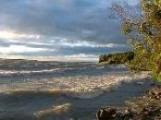Lake Simcoe - People are the problem
People are the problem.
That was the conclusion of a investigation focusing on Lake Simcoe and the factors that threaten its health, with urban sprawl and climate change named as major concerns.
"One way or another, it comes back to our personal responsibility," said Brent Kopperson, executive director of the Windfall Ecology Centre, one of two organizations involved in the study.
Skyrocketing growth in areas bordering the lake is putting increased strain on this precious resource, a situation that is expected to worsen as new development continues in the watershed area.
"Primarily that is a result of the way we are building our communities, the population growth," Kopperson added.
Released on Wednesday, the study was co-sponsored by the Ladies of the Lake, a non-profit group of more than 100 women working to protect the water body from future harm.
The group, which includes members from the Orillia area, hopes to act as a bridge between government and the residents whose homes border the lake, with the long-term goal of creating a plan to combat the forces that threaten the lake's health.
"There have been many, many studies done, but never has there been a plan to do anything about it," said the organization's co-founder, Jane Meredith. The non-profit group raised eyebrows - and $250,000 - when members posed nude for a glossy calendar celebrating Lake Simcoe.
Meredith, who hails from the Keswick area, was among them.
"It was like no other experience before, but it was tremendous fun," she added with a laugh. "We accomplished our goal and then some."
Proceeds from the popular page-turner will support public education programs, including four events taking place at various locations around the lake this weekend. Armed with digital cameras, participants will document the impacts of urbanization, agriculture, invasive species, and climate change on the lake, while helping create a community action plan, to be unveiled in the fall. Locations include Innisfil, Barrie, the Holland River, and Georgina. "We had no idea of the reaction we were going to get," Meredith added of the publicity that followed the calender's publication. "It was incredible."
Prior to the report's release, past investigations of the lake focused on individual risk factors, with each studied in isolation. The Naked Truth - as the study has been dubbed - gathers those findings together under one roof, so to speak. "These things are all interrelated and you really can't look at just one thing," Kopperson added. "They all relate back to human activity."
The run-off of phosphorous into the lake from urban and agricultural areas has led to excess growth of weeds, algae and alien plants.
Researchers discovered "many canaries in our coal mine," Kopperson said, adding that rising temperatures are impacting harshly on fish habitat.
Wild trout are on the verge of disappearing, while some stocked fish "cannot reproduce," he added.




2 Comments:
Packers and Movers India
Packers and Movers in Bangalore
Packers and Movers in Delhi
Packers and Movers in Hyderabad
Packers and Movers in Mumbai
Packers and Movers in Chennai
Packers and Movers in Pune
Packers and Movers in Noida
Packers and Movers in Gurgaon
Packers and Movers in Ghaziabad
Packers and Movers in Faridabad
Packers and Movers
Movers and Packers in Hyderabad
Movers and Packers in Bangalore
Movers and Packers in Delhi
toms outlet store
huaraches shoes,men huaraches,women huaraches,kid huaraches
ralph lauren online,cheap ralph lauren
michael kors handbags,michael kors handbags clearance,michael kors clearance
cheap oakleys
air huarache shoes
kobe shoes
true religion jeans
michael kors handbags
michael kors outlet store
black huaraches
fitflops sale
Michael Kors Outlet Online
http://www.michaelkors-outletfactory.us.com
http://www.michaelkors-outletwebsite.com
michael kors outlet store
Air Jordan 11
fitflops clearance
michael kors handbags
mlb jerseys authentic
cheap oakley sunglasses
kobe byrant shoes
kobe sneakers
Michael Kors Purses
michael kors factory outlet
Post a Comment
<< Home